Региональные проблемы развития туристского сервиса. Рубрика в журнале - Современные проблемы сервиса и туризма
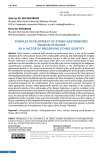
Complex development of ethno-gastronomic tourism in Russia as a factor of preserving ethnic identity
Статья научная
Ethnic tourism, combined with elements of gastronomic tours, is one of the possible directions of the ethnocultural revival of the small peoples of Russia, and maintaining the integrity of the ethnic cultural space. Ethno-gastronomic tourism is able to help small regions of the Russian Federation to create their own unique trade offer in the tourism market during the postpandemic crisis and contribute to the creation of new jobs in the tourism industry for the indigenous autochthonous population. Analysis of socio-economic factors in the development of ethnogastronomic tourism in the context of preserving the identity of the small peoples of Russia and the development of practical recommendations aimed at diversifying the tourist product and ethnic self-identification of small peoples, contains the following tasks: an overview of the theoretical and methodological foundations of the development of ethno-gastronomic tourism; research of the most popular Russian tourist destinations and the prospects for their development; analysis of the target audience and the degree of demand for ethno-gastronomic tours at the present stage; development of practical proposals for the modernization of the organizational and economic mechanism of ethno-gastronomic tourism. Ethno-gastronomic tourism can draw attention to the problem of preserving the identity of the small peoples of the Russian Federation, as well as contribute to the infrastructural and economic development of sparsely populated regions of the country. Based on the theoretical and methodological foundations of the formation and functioning of ethno-gastronomic tours, the study of their influence on the creation of a regional tourist product in the period of world globalization made it possible to give a general description of the tourist resources of the regions of Russia, contributing to the integrated development of ethno-gastronomic tourism; assessment of the state and development trends of tourist potential in areas with small population groups; to develop recommendations for its development in the regions of the Russian Federation.
Бесплатно
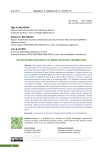
Developing strategy of wine festival promotion
Статья научная
The purpose of this paper is to determine how wine festival criteria impact on their promotion, and to develop practical recommendations and a strategy for wine festivals both during and after the COVID-19 pandemic. Design/methodology/approach - Qualitative data from 29 wine festival websites were gathered. Content analysis was used to establish criteria that affect promotion of wine festivals. Crosstabs were used to check whether established wine festival criteria affect a festival’s decision to disclose a participating wineries list as part of a marketing effort. The Alignment Squared model was used to draw up recommendations for organizing wine festivals during the COVID19 pandemic. Findings - Neutral, positive and negative criteria that have an impact on promotion of wine festivals were determined and practical recommendations were suggested on how wine festivals could benefit from these criteria. The connections between the general running time of wine festivals and their all-year-round marketing circle were studied. The statistical connection between wine festival criteria and its tendency to practice cross-marketing with participating wineries were examined. Originality - Recent studies do not consider and systematize the strategies for wine festival promotion. The criteria described in this study may be used as a basis for a comprehensive classification of wine festivals and bring valuable insights into organization of wine festivals around the world, while practical recommendations may be used as a guideline for organizers of wine festivals after the COVID-19 pandemic and if world crises like this ever happen again.
Бесплатно
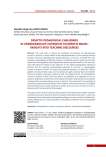
Статья научная
This work aims to discuss the challenges of Educators of undergraduate courses in tourism in Brazil related to the operationalization of the teaching-learning process of Tourism. Regarding the specific objectives, we aim to: i) identify the main teaching methodologies of Brazilian teachers; ii) identify relevant aspects for teachers about their training path or their professional trajectory of these teachers. The main concepts discussed are related to the reflection on the didactic-pedagogical training of teachers and the teaching methodologies proposed by teachers in undergraduate courses in tourism in Brazil. To achieve the proposed objectives, we opted for a bibliographic and documentary study, and an analysis through analytical tools derived from Discourse Analysis, interviews conducted with 34 professors from 19 undergraduate courses in tourism in Brazil. Our main goal is to contribute to a reflection on the importance of giving more attention to the subject of teacher training of instructors of both undergraduate and postgraduate courses in tourism. The results point to recognition of the absence of formative possibilities in the academic environment and the use of different teaching practices usually centered on written texts and, more recently, on new information and Communication Technologies. This paper is the result of a doctoral study entitled "The audiovisual in higher education instructors' practice in tourism in Brazil: interfaces and tensions with leisure", which was developed in the Interdisciplinary Postgraduate Program in leisure studies of Federal University of Minas Gerais, under the guidance of Professor Christianne Luce Gomes (ANJOS JÚNIOR, 2021).
Бесплатно
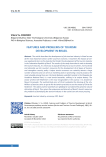
Features and Problems of Tourism Development in Brazil
Статья научная
The article describes the development of the tourism industry in Brazil as one of the most important sectors of the country's economy. It examines the impact of various negative factors on this industry that hinder the development of the tourism industry in the Federative Republic of Brazil. The results of the study show that in order to develop the tourism industry, it is necessary to popularize Brazil as a tourist center, more actively and rationally use the country's resources for the development of all types of tourism, and strengthen security policy. Unique tourist resources can certainly attract a large number of tourists and can serve as marketing tools in promoting a tourist product, the most valuable among them are: the Santa Barbara waterfall, located in the Chapada dos Veadeiros National Park, is a real tourist bestseller, striking in its unique beauty. The statue of Christ the Redeemer is the most recognizable in the country. It is located on Mount Corcovado. The outstretched arms of Christ symbolize the blessing of the city. Millions of tourists strive to get to Rio de Janeiro precisely to see the statue of Christ the Redeemer. The Adam and Eve waterfall can rightfully be considered the greatest natural attraction of Brazil. Thus, given the uniqueness and diversity of Brazil's tourist resources, the problems of developing the tourism industry in the country are the most pressing.
Бесплатно
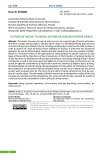
Future of niche tourism: diving in Russian water areas
Статья научная
This article discusses the role of niche tourism as a special type of tourist attractions that form a unique tourist product. The goal of the study is to identify promising ways to boost of extreme diving tours offered in Russia, including possible ways to improve the skills of divers in order to expand the range of diving services adaptive for tourism. A systematic and situational approach, as well as formal logical analysis and desk research are the main research methods. Based on a literature review on the approaches to understanding the specific features of niche types of diving and the importance of tourist impressions in the formation of customer loyalty, the author discusses the development of such types of diving as Cave Diving and Bog Diving in Russia and abroad, as well as the main trends that affect the prospects for boost. Among these are: the search for effective combinations of regular tours with new elements of different types of diving; the popularization of extreme diving training programs not only within the framework of volunteer programs or as a personal hobby of individual clients, but also as an integral part of a tourist product with increased value for the client; the formation of diving infrastructure from the position of a tourist object. The main paths of further research are a comparative analysis of the best management practices and the development of a system of indicators for assessing the quality of a niche tourist product provided to visitors of Russia's diving centers.
Бесплатно
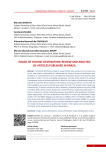
Image of tourist destination: review and analysis of articles published in brazil
Статья научная
The tourist destination image is recognized by many scholars in the area as one of the main factors responsible for influencing the tourist’s choice of destination and, therefore, an essential factor to be considered in destination tourism management and planning, in order it can be sustainably competitive. The aim of this article is to conduct a systematic review of articles published in Brazil on the subject of destination image to provide an overview of how studies on the subject are being carried out. To this end, the SPELL platform was used to identify and collect the data. The sample of this study was compound by 23 articles existing on SPELL database, published between the years 2008 and 2020. Most of the articles studied are characterized as exploratory-descriptive research, empirical in nature, balancing between quantitative and qualitative methodological approaches. The main publications that serve as a basis for destination image studies were identified: Baloglu and Maccleary (1999); Echtner and Ritchie (1991); Gallarza, Saura and García (2002); Beerli and Martín (2004) and Chagas (2008). The results of this study seek to contribute to the scientific development about the tourist destination image serving as a basis to guide future studies on the subject and, consequently, to contribute to the development of tourist destinations.
Бесплатно
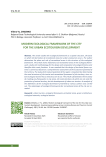
Modern ecological framework of the city for the urban ecotourism development
Статья научная
The article studies the ecological framework as a spatial structure, the basis on which the formation of recreational areas for urban ecotourism occurs. The author determines the place and role of recreational areas in the structure of the ecological framework. The article shows importance of recreational areas in the ecological framework, studies the methodology for the design and composition of ecological frames and identifies their main functions. It was revealed that the design of territorial frame systems is carried out based on a comprehensive assessment of the ecotourism potential of the territory. The study of the natural potential of the region is important for determining the areal structures of the tourist and recreational framework of the territory, since urban ecological tourism has a clear focus on its use. The article substantiates the necessity of creating eco-frameworks in city areas, the main functions of which are not only the protection of natural territory, but the development of urban eco-tourism. An analysis of the definitions of the ecological framework presented by various authors was carried out. The advantages of ecological frameworks for recreational areas of the city are revealed.
Бесплатно
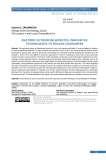
Rhetoric in tourism websites: innovative technologies to engage consumers
Статья научная
The persuasive power of advertising discourse is very much experienced today. The same happens in relation to tourism marketing materials. In order to attract the attention of the viewers, the travel companies choose various techniques to express their notion of the brand. Technologies are constantly evolving bringing new solutions for web designers. Hence, there exist different innovative approaches in tourism marketing to attract and convince potential tourists to book a tourism product. The present article elucidates and discusses new technological solutions for tourism websites to allure potential tourists. The paper reviews the elements of persuasive web tourism marketing, such as 3D virtual tour, online webcam, interactive map, Google Maps, and online booking form. These technologies provide useful information, create additional experiences in the viewers and help them finalize their decisions. The article highlights how these components as persuasive strategies of tourism promotional materials can influence the decisions of tourism websites’ users. The result section provides the real examples of deployment of the mentioned technologies in influencing the audience by the websites of “Karpaty” and “Solva” resorts (Ukraine). All these techniques form a theoretical framework for researches on persuasiveness and are worth attention as they play an important role in the promotion of tourism services. The data collection of this study will provide updated information in relation to rhetoric of tourism.
Бесплатно
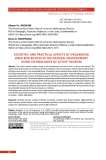
Статья научная
The article reveals modern trends in the development of tourism both in Russia and abroad. The authors first of all provide an overview of trends emerging in the pre-coronavirus period and associated with a shift from mass-tourism to its sustainable forms. The study as well underlines the problems that emerged during the COVID-19 pandemic, both in consumer demand and by tourism providers. Particular attention is paid to the types of domestic tourism, which, according to experts, will receive an additional impulse for development in the post-coronavirus period. The practical aspects of organizing weekend itineraries as a promising type of domestic tourism are considered on the example of the internal regions of the Kaliningrad region of Russia located on the mainland adjacent to the Curonian lagoon. According to the results of the study, an integrative model of the formation of a recreational effect by active tourism technologies was developed taking into account the concept of sustainable development in post-coronavirus conditions. Field studies were carried out as part of the implementation of the international project of the Lithuania-Russia Cross-Border Cooperation Programme 2014-2020 ““Сommon Heritage of Curonian lagoon: from Extraordinary to Familiar - CROSS-HERITAGE».
Бесплатно
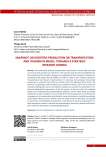
Статья научная
The relationship between transportation and tourism is inseparable, and both are services that provide user experiences. The systemic view has been paradigmatic for the treatment of this interface. However new approaches have emerged, including others based on the larger web of mobility. In order to create a new research agenda on Transportation and Tourism involving Brazil, it is necessary to investigate the scientific production to verify the state of the art, which is the main objective of this study. This research is exploratory and descriptive of a qualitative nature, and it was carried out through a bibliographic survey and software support was used for the spreadsheet, textual and geographical approaches. As for the results, on the one hand, this snapshot allows us to understand the epistemological advances. On the other hand, it provides indications for these advances to be incorporated into the discussions on planning and management of transportation and Brazilian tourist destinations, constituting premises of the Applied Social Sciences. Besides, from the state of the art identified, it is possible to launch new interdisciplinary perspectives on the future of research, proposing a strategic agenda for research in tourism and transportation, based on creativity and innovation in both the theoretical and methodological fields.
Бесплатно
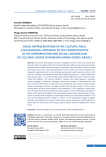
Статья научная
This article investigates the power struggles inherent in the social representations of cultural heritage within the context of Mariana, Minas Gerais, focusing on their appropriation and legitimation processes. Grounded in Pierre Bourdieu’s theory of fields and Serge Moscovici’s Social Representations Theory (SRT), the study examines how competing representations among heritage preservation agents operate within a field of forces. Findings reveal that the institutional (official) perspective – which dictates heritage listing criteria – is predominantly shaped by the hegemonic representations dominating this subfield. The research adopts a multiple case study approach, analyzing agents engaged in Mariana’s heritage preservation through: a) Questionnaires and semi-structured interviews; b) Systematic non-participant observation; c) Documentary analysis (newspaper archives, municipal records). Key outcomes include: 1) The contextual dynamics of social representation (SR) production; 2) The typology of representations and their hierarchical positioning among agents; 3) The contestation and legitimization of SRs within the subfield. The study demonstrates that a representation’s dominance correlates with its degree of social dissemination and institutional validation. The most socially legitimized SRs emerge as "victors" in the ideological struggle to define heritage. Consequently, the research underscores how economic and cultural capital underpin both the construction of heritage representations and their legitimation mechanisms.
Бесплатно
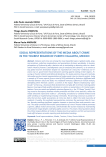
Social Representations of the Media About Crime in the Tourist Region of Puerto Vallarta, Mexico
Статья научная
Violence and crime are among the most impactful topics in global media, shaping narratives, collective imaginations, and perceptions of places worldwide. In tourism, perceptions of (in)security play a decisive role in motivating or deterring visits to a destination. Mexico presents a paradigmatic case for analyzing this dynamic, as it remains a top global tourism destination despite its reputation for insecurity—evidenced, for instance, by U.S. government travel advisories warning against visiting certain regions. Focusing on Puerto Vallarta and Bahía de Banderas, this study examines how print and digital media construct social representations of violence and crime in a tourist context. Using a sample of 97 news reports (from a total of 622) published by Noticieros (affiliated with Televisa) between 2015 and 2020, we employed Iramuteq software for lexical analysis, identifying three thematic clusters: 1) Crimes in the region: Reports emphasizing "spectacular" crimes (e.g., shootouts) that deviate from everyday life; 2) Crimes involving public figures: Coverage of high-profile individuals as victims or perpetrators; 3) Criminal organizations: Focus on cartels and globally notorious figures (e.g., the "El Chapo" family). Findings reveal a discrepancy between media portrayals and local crime statistics, where the media selectively represents violence – prioritizing sensational or celebrity-linked events while omitting or euphemizing everyday criminality. This framing constructs a partial reality that anchors public perceptions of crime but fails to reflect the lived insecurity of residents. Crucially, this mediated representation minimizes the perceived risks for tourists, thereby avoiding significant negative impacts on tourism flows and economic revenue. The study concludes that media representations of crime in Puerto Vallarta promotes a generic, diffuse notion of insecurity, which benefits the tourism industry by maintaining an attractive image despite underlying safety concerns. This raises critical questions about the ethical responsibilities of media in shaping tourist perceptions and the socioeconomic trade-offs between accurate reporting and destination branding.
Бесплатно
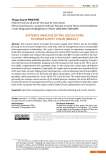
Systemic analysis of the Juiz de Fora tourism supply chain (Brazil)
Статья научная
This research aimed to analyze the tourism supply chain (TSC) in Juiz de Fora (MG), focusing on its structural components, main links, internal management process and possible inter-organizational relationships. We used a literature review on operations management, production management, production planning and control (PCP), logistics and supply chain on tourism, to analyze and compare the proposed concepts and offer a model related to the tourism product. Methodologically, this study used a mixed research, mainly quantitative but with some complementary qualitative questions. It was conducted a systematic mapping, through a non-intentional and probabilistic sampling with 100 companies that make up the TSC in Juiz de Fora (MG), complemented with qualitative data, on the reasons for certain types of behavior and practices of these companies. Empirically, the supply chain in question was considered from all its main links, namely: lodging, food, travel agencies, cultural equipment and transportation. Its analysis was carried out on the basis of 6 blocks of questions, each of them having a set of questions, which generated an “x-ray” of the TSC in Juiz de Fora. The results show that despite generating an average annual revenue of 3.6 million/year per company, the sector still lacks internal improvement in management practices, as well as inter-organizational integration, which leads to the conclusion that the output could be better if such optimizations were introduced.
Бесплатно
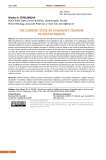
The current state of children's tourism in Lipetsk region
Статья научная
The article examines the main trends in the development of children’s tourism in the Russian Federation, identifies the obstacles to children’s tourism’s fulfillment of its significant role: to participate in the upbringing, education and health improvement of the younger generation. The destruction of the socio-economic system of the Soviet state radically changed the structure and approaches to organizing children’s tourism in the Russian Federation. The author presents a generalized picture of negative processes in children’s tourism, based on the results of statistical data over the past 5 years and the results of recent scientific research. At the state level, a number of measures are being taken to resolve the situation, which relate to changes in the regulatory framework and in organizational and management structures. These numerous attempts, however, do not create conceptual foundations in the development of children’s tourism, do not have a systemic nature and, as a result, do not give the desired effect. Regional specifics in the children’s tourism development reflect the national trends. This is clearly demonstrated by the experience of the Lipetsk region, in which, along with negative trends, the author traces a number of positive points: an increase in the number of children who have rested in children’s health camps, the continuation of the traditions of tourism and local history work on the basis of additional education institutions and within the framework of organizing one-day and multi-day tourist trips, activities of the Argamach Archaeological Park and The Forest Park. The article identifies a number of organizational decisions and initiatives as promising areas (the creation of the Committee for the Development of Children’s Tourism in February 2020, the results of the Committee’s meetings in 2020), which should raise the level of development of children’s tourism.
Бесплатно
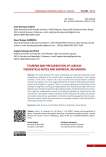
Tourism and precarisation of labour: theoretical notes and empirical incursions
Статья научная
This study discusses the issues of hijacking and capturing subjectivity under manipulative capitalism in the current labour conditions and relations in the tourism economy. In this sense, it points out to the structural trend of precarisation of labour among travel agents, even more aggravated by the demand for high professional qualification and excellence in services. There is a certain adjustment of the worker to the company's imaginary; a feeling of indispensability and worthiness for effort and merit; adhesion and involvement with the organizational whole, materialized by teamwork; belief in effective collaboration at work; and feeling of self-delivery, self-giving and selfcommitment. This implies a labour context of intense imposition of conduct on workers, who need to demonstrate sympathetic and total personality engagement for the reproduction of capital, despite the precariousness of working conditions and relationships in many sectors of tourism activity.
Бесплатно
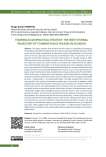
Tourism as geopolitical strategy: the institutional trajectory of tourism public policies in Ecuador
Статья научная
This paper analyzes how tourism has been used as a geopolitical strategy by the Republic of Ecuador throughout the last century, gaining remarkable relevance in the recent period, being considered as an alternative source of development in the context of the restrictive capacities and resources of the National State. In particular, we analyzed the institutional trajectory of tourism public policies in Ecuador, between 19902020, focusing on the role and form of state action in this process. To this end, an empirical study was carried out, based mainly on secondary data collected from the official press of the Republic of Ecuador, in its three branches (executive, legislative and judiciary). From a total of 19,026 documents initially identified, we reviewed and found a total of 223 normative acts specifically dedicated to the tourism issue. This material was analyzed using the institutional model of public policy analysis elaborated by Pimentel (2011; 2014), structured in 3 dimensions and 5 categories, which deals with the normative, regulatory and cognitive dimensions, drawn upon a synthesis of several categories identified by Scott - among others - on institutional theory. The data showed that: a) there is a clear growth in the volume of national normative acts in the period in question, which suggests that tourism has become a State policy, b) the policies are “initiated” and have the executive as the main participating actor, c) however, they are mostly generic acts and poorly linked to operational actions (with plans, projects and measurement instruments) what suggest that extraofficial actions have been taken in order to promote and operate the sector, and d) they are characterized by the absence of resources to make them feasible. We conclude tourism has become a state policy, in terms of the discursive and also institutional level of official actions taken by the national government, as well as the practice we can see in relation to inbound and domestic flows. However, the way the subject is handled lacks support, especially material and financial one, for its effective execution, which suggests that it may have any other - no official and/or institutional - different force driving the sector, while public policies appear as a shadow on the sector's performance.
Бесплатно
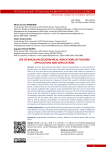
Use of Brazilian geographical indications in tourism: applications and implications
Статья научная
Services and products (agri-food, mineral, handcrafting, or industrial) from a specific place are linked to the place historical-cultural-environmental context. When there is a very close link of the goods/service to the place that renders it notoriety or specificities, these might be recognized as Geographical Indications (GIs). By bearing the territory’s name and other immaterial aspects, the GI is naturally assimilated to the region and related activities such as tourism might develop. This tourism application occurs and is studied in several countries. However, in Brazil, this research is limited to particular cases. This raised the question whether (and how) a broader use in tourism exists, thus, we sought to verify whether and how geographical indications are allied to tourism in Brazil. To achieve this aim, we promoted a theoretical discussion related to GIs and tourism, and also collected data using an online questionnaire that was sent to representative entities of Brazilian geographical indications known at the time of the development of this study. We obtained 55 replies that were investigated using descriptive statistics, correlations, and content analysis. Our results revealed tourism activities related to some national GIs. On the other hand, there are some registered, but without effective use (due to lack of structure, articulations, or resources). Another finding pointed out the need to disseminate the theme among tourists and producers in general, aiming at the GI valuation and implementation of actions that promote their use as an asset.
Бесплатно
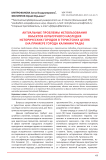
Статья научная
В статье представлен обзор теоретических и практических подходов отечественных и зару- бежных авторов к вопросу использования объектов культурного наследия для развития регио- нального туризма. Большинство учёных определяют объекты культурного наследия в качестве одного из важнейших условий для развития культурно-познавательного туризма. Дальнейшее развитие данной территории обеспечивают стратегическое планирование, государствен- ная политика, создание нормативно-правовой базы, разработка специализированных государ- ственных программ, привлечение инвестиций, создание специализированной инфраструктуры и проведение грамотной маркетинговой политики. В статье рассмотрены лимитирующие факторы использования объектов культурного насле- дия в Российской Федерации на примере Калининградской области. Изучены институциональные возможности и государственные инструменты восстановления объектов культурного насле- дия с целью их включения в региональный туристский продукт. Разработана и предложена авторская методика систематизации объектов историко-культур- ного наследия, используемых в туристских целях. Критерием ранжирования объектов является степень их сохранности, доступности и функциональное назначение. Методика апробирована на объектах культурного наследия города Калининграда, относящихся по своему функциональ- ному назначению к фортификационным сооружениям, однако она может быть использована в научных исследованиях и на практике для ранжирования и других видов объектов культурного наследия регионов Российской Федерации.
Бесплатно
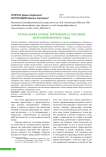
Алтарь мира в Риме: материалы к пособию для современного гида
Статья научная
Статья отражает современные тенденции в музеологии и научных направлениях, связанных с историко-культурным туризмом. Она строится на пересечении нескольких дисциплин, занимающихся интерпретацией древних архитектурных памятников, - теории и истории пространственных искусств, гражданской (политической) истории Древнего Рима, истории римской религии и градостроительства. Для современного гида и музейного работника статья будет полезной как выражение актуального на сегодняшний день подхода, который направлен не столько на изучение памятников и коллекций, сколько на установление взаимодействия с аудиторией, т.е. с современными горожанами. В этом взаимодействии экскурсант рассматривается в качестве полноправного участника коммуникации, а не пассивного получателя научных сведений и эстетических впечатлений. Музейный экспонат, в свою очередь, описывается с точки зрения коммуникации между экскурсантом и реальной вещью, сформированной градостроительной, политической, религиозной и художественной логикой древней культуры. Для апробации действенности такого подхода авторы выбрали алтарь Августова Мира в Риме. При описании алтаря предпринимается попытка восстановления городского контекста этого сооружения (ныне утраченного ввиду разрушения алтаря после падения империи и позднейшей застройки Марсова поля, а также его дальнейшего перемещения). В целях наглядности делается сопоставление пропагандистских приёмов, используемых в древних культовых сооружениях и в памятниках тоталитарных эпох. Анализ строения и иконографической программы алтаря Мира призван помочь экскурсанту раскрыть в себе собеседника древних памятников архитектуры и скульптуры, а экскурсоводу - восстановить и представить музейный объект в контексте жилой среды, пусть на сегодняшний день и полностью или частично утраченной. Этот подход может быть использован при работе с объектами in situ.
Бесплатно
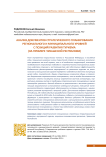
Статья научная
Рост внутреннего туристского потока в Российской Федерации в последние годы, повышение внимания к роли туристской отрасли в социально-экономическом развитии как всей страны, так и её отдельных территорий, вызывают необходимость пересмотра подходов к стратегическому планированию развития индустрии туризма и гостеприимства. Для обеспечения эффективности бюджетного финансирования мероприятий по развитию туризма на региональном и муниципальном уровнях требуется соблюдение единства концепций, целей, задач, показателей и других структурных элементов общих и отраслевых документов стратегического планирования, что не всегда достигается на практике. Статья посвящена анализу современной научной литературы, нормативно-правовых актов по проблемам стратегического планирования, оценке имеющейся практики в данной области на региональном и местном уровнях с позиций рационального использования имеющихся ресурсов, повышения конкурентоспособности территорий, адаптивности системы управления к меняющимся условиям внутренней и внешней среды. Для анализа выбрана Чувашская Республика, где в 2023 году была разработана стратегия развития туризма региона на период до 2035 года. В исследовании собрана и систематизирована информация о реализуемых на территории данного субъекта РФ документах стратегического планирования регионального и муниципального уровней через призму развития туризма. Полученные результаты исследования могут быть использованы в ходе решения задач по повышению устойчивости институтов долгосрочного планирования, а также при подготовке и реализации новых стратегических документов в сфере туризма.
Бесплатно

